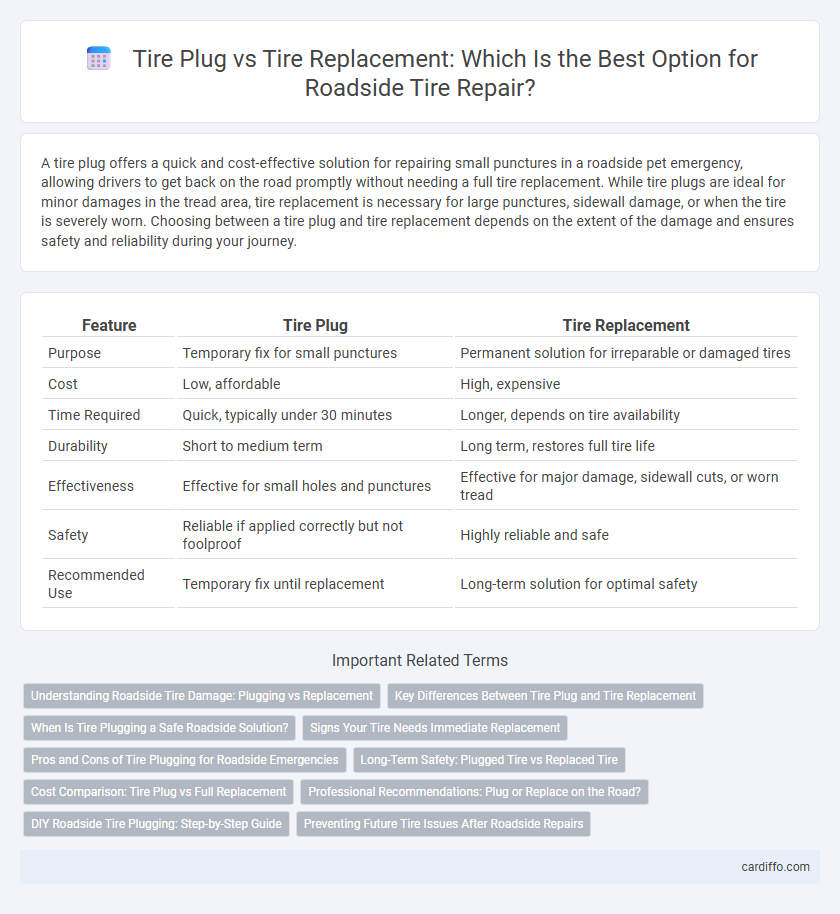A tire plug offers a quick and cost-effective solution for repairing small punctures in a roadside pet emergency, allowing drivers to get back on the road promptly without needing a full tire replacement. While tire plugs are ideal for minor damages in the tread area, tire replacement is necessary for large punctures, sidewall damage, or when the tire is severely worn. Choosing between a tire plug and tire replacement depends on the extent of the damage and ensures safety and reliability during your journey.
Table of Comparison
| Feature | Tire Plug | Tire Replacement |
|---|---|---|
| Purpose | Temporary fix for small punctures | Permanent solution for irreparable or damaged tires |
| Cost | Low, affordable | High, expensive |
| Time Required | Quick, typically under 30 minutes | Longer, depends on tire availability |
| Durability | Short to medium term | Long term, restores full tire life |
| Effectiveness | Effective for small holes and punctures | Effective for major damage, sidewall cuts, or worn tread |
| Safety | Reliable if applied correctly but not foolproof | Highly reliable and safe |
| Recommended Use | Temporary fix until replacement | Long-term solution for optimal safety |
Understanding Roadside Tire Damage: Plugging vs Replacement
Roadside tire damage often requires a quick assessment to determine whether a tire plug or full tire replacement is necessary. A tire plug is suitable for small punctures in the tread area that do not affect the tire's structural integrity, providing a temporary but reliable fix. When damage involves sidewalls, large punctures, or severe tread separation, tire replacement is essential to ensure safety and maintain vehicle performance.
Key Differences Between Tire Plug and Tire Replacement
Tire plug repairs a puncture by sealing the hole from the inside without removing the tire, suitable only for small tread-area punctures, whereas tire replacement involves removing and replacing the entire tire, necessary for severe damage or sidewall punctures. A plugged tire restores air pressure temporarily and may not be as durable or safe, while a replaced tire guarantees full structural integrity and long-term reliability. Cost and time efficiency favor tire plugs, but tire replacement ensures optimal vehicle safety and performance.
When Is Tire Plugging a Safe Roadside Solution?
Tire plugging is a safe roadside solution when the puncture is limited to the tread area, typically less than 1/4 inch in diameter, and not located on the sidewall or shoulder of the tire. It effectively seals small holes caused by nails or sharp objects, restoring air retention without compromising tire integrity. For larger or sidewall damage, tire replacement is necessary to ensure vehicle safety and performance.
Signs Your Tire Needs Immediate Replacement
Visible sidewall damage, deep tread separation, or large punctures are clear signs your tire requires immediate replacement to ensure safety. Tires with uneven wear patterns or bulges indicate structural weakness that cannot be reliably repaired by a tire plug. Prioritizing tire replacement over plugging prevents blowouts and maintains proper vehicle handling on the road.
Pros and Cons of Tire Plugging for Roadside Emergencies
Tire plugging offers a quick and cost-effective solution for repairing punctures during roadside emergencies, allowing drivers to avoid the inconvenience of tire replacement and continue their journey safely. However, tire plugs are generally recommended only for small punctures in the tread area and may not provide a permanent fix, potentially leading to air leaks or failure under high speeds. While tire replacement ensures full tire integrity and longevity, plugging serves as a practical short-term fix to restore mobility without the immediate expense and effort of changing the entire tire.
Long-Term Safety: Plugged Tire vs Replaced Tire
Tire replacement offers superior long-term safety compared to tire plugging by restoring the tire's original structural integrity and ensuring consistent vehicle handling. While a tire plug provides a temporary fix for punctures, it does not address potential internal damage, increasing the risk of future blowouts. Professional tire replacement reduces roadside hazards by delivering reliable performance and enhanced durability for extended travel.
Cost Comparison: Tire Plug vs Full Replacement
Tire plugs typically cost between $10 and $30, offering an affordable, quick fix for minor punctures without removing the tire from the rim. In contrast, full tire replacement can range from $100 to $300 or more per tire, driven by brand, size, and type of tire, representing a significant investment. Choosing between a tire plug and a full replacement depends on the damage extent, with plugs providing cost-effective short-term repairs and replacements ensuring long-term safety and tire integrity.
Professional Recommendations: Plug or Replace on the Road?
Professional recommendations emphasize that tire plugs are suitable for small punctures in the tread area, providing a quick and cost-effective temporary fix on the road. For sidewall damage or large punctures, tire replacement is strongly advised to ensure safety and maintain tire integrity. Roadside experts prioritize assessing the damage extent and tire condition before deciding between plugging or replacing.
DIY Roadside Tire Plugging: Step-by-Step Guide
DIY roadside tire plugging involves identifying the puncture, removing the object causing the leak, and cleaning the hole with a reamer tool before inserting a rubber plug to seal the tire temporarily. This method offers a cost-effective and quick solution compared to full tire replacement, allowing drivers to continue their journey safely until professional repair is possible. Proper use of a tire plug kit with tools like insertion needles and vulcanizing glue ensures an effective seal that maintains tire pressure on the roadside.
Preventing Future Tire Issues After Roadside Repairs
Tire plug repairs offer a quick, cost-effective solution for small punctures, helping prevent immediate air leaks and allowing safe continued driving. However, tire replacement is essential for severe damage or sidewall punctures, ensuring long-term safety and reducing the risk of blowouts or tread separation. Regular tire inspections and professional repairs after roadside fixes enhance durability and prevent future tire issues on the road.
Tire Plug vs Tire Replacement Infographic

 cardiffo.com
cardiffo.com